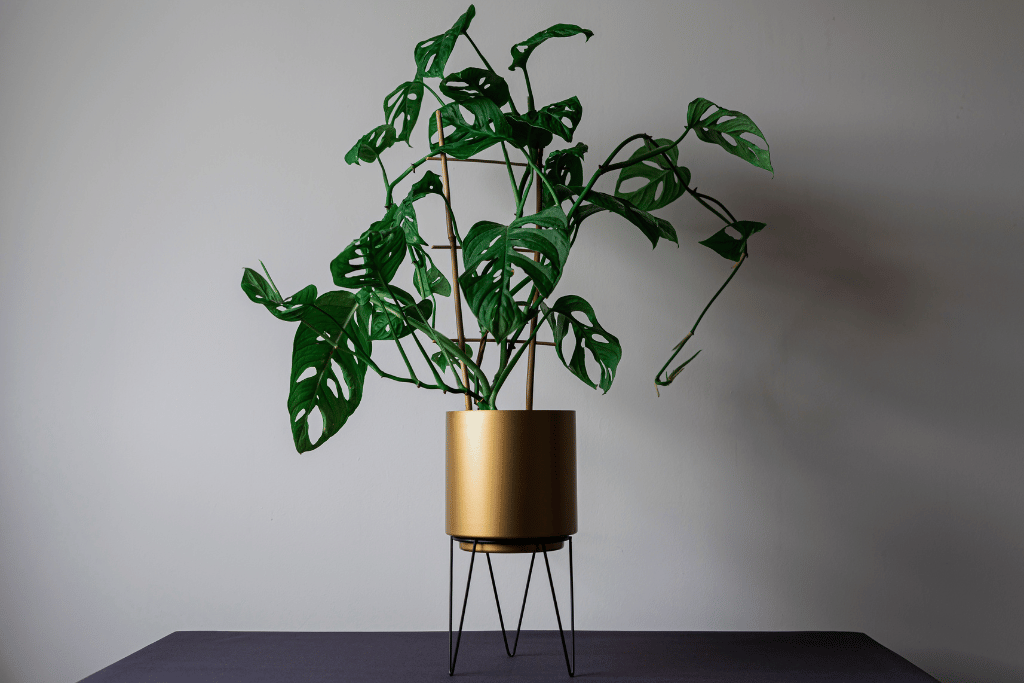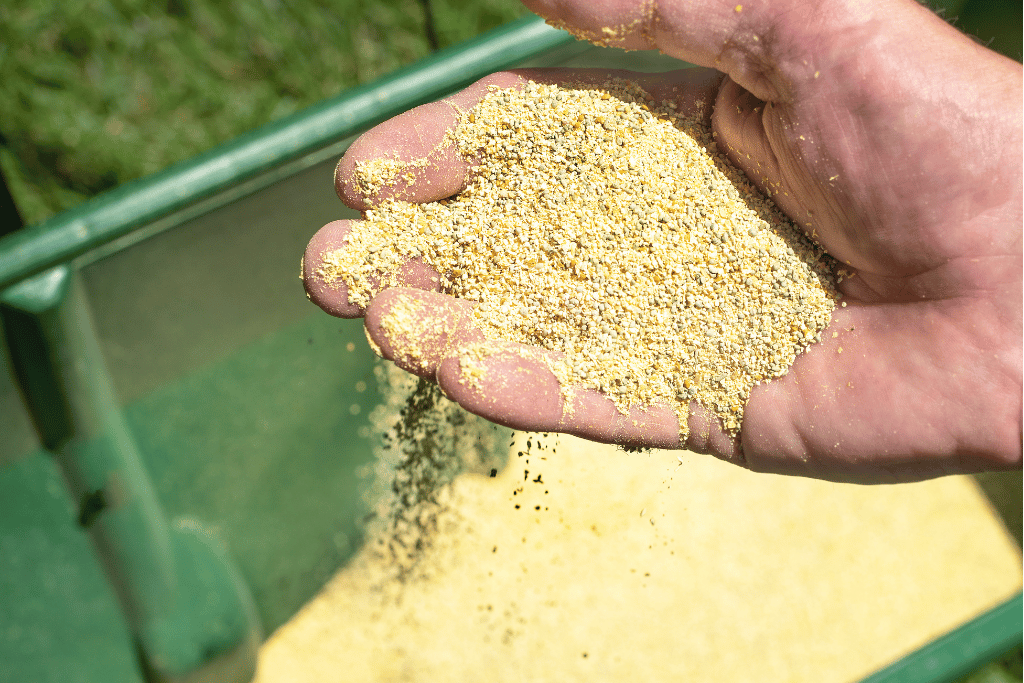
Have you ever found yourself admiring the beautiful foliage of your potted plants, only to discover a wiggly little creature hiding in the soil? While the presence of various types of worms in potted plants may seem alarming at first, it can actually be a sign of a healthy and thriving ecosystem. These wriggly creatures play a vital role in aerating the soil, breaking down organic matter, and improving overall plant health. However, it’s important to highlight that not all worms are created equal – some are beneficial, while others may pose a threat to your beloved greenery. In this article, we’ll explore the most common kinds of uninvited guests that you may encounter in your precious plants, and how to identify them.
Different Types of Worms in Potted Plants
1. Grub Worms

Grub worms, also known as white grubs, are the larvae of certain beetles, such as the Japanese beetle or the June bug. They are white or cream-colored, have a C-shaped body, and can grow up to an inch in length. These little critters may look harmless, but they can cause significant damage to your plants.
They typically feed on the roots of grasses and other greens, which can stunt growth and even kill the plant if left unchecked. Also, they might attract other pests, such as moles, skunks, and birds, furthering the deterioration of your leafy friends.
The signs of a grub worm infestation include brown or dead patches of grass, wilted or yellowed leaves, and plants that are easily uprooted. You may also notice adult beetles flying around the affected greens, especially during the summer months.
If you suspect that your plants have been attacked by these parasites, there are a few steps you can take.
First, try digging up a small section of soil around the plant to look for the larvae. If you find them, don’t hesitate to step up. Leverage natural predators, such as nematodes or birds that control the population of grub worms, or apply an insecticide specifically designed to target them. Be sure to follow the instructions on the label carefully, and always wear protective clothing and gloves when handling chemicals.
2. Pot Worms

Pot worms are small, slender, and white-colored pests, commonly found in the potting mix. They are typically less than an inch long and have a distinctive wavy movement when they move through the soil. These vermin are not harmful to plants and can actually be beneficial to the soil ecosystem.
Pot worms are often present in organic mixes and compost, as they feed on decaying plant matter. They take part in breaking down organic matter and releasing nutrients back into the soil, fostering the growth of plants. However, having too many of them in a container runs the risk of them starting to feed on the roots.
The signs of pot worm infestation may be difficult to detect as they typically only bring about minor symptoms. The most common indicator is held-back growth or wilting, which means chances are worms had begun feasting on the roots. In severe cases, you might see the critters crawling on the surface of the soil or coming out of the drainage holes at the bottom of the container.
Among the types of worms in potted plants, pot worms are not a serious threat. In moderate numbers they can be left unbothered, however, if you suspect a potential overpopulation, don’t hesitate to eradicate them. One simple way for this is to allow the potting mix to dry out more between waterings, as these pests prefer moist soil. You can also try adding a layer of sand or perlite to the top of the soil, which will make it more difficult for the critters to crawl on the surface. If these methods do not work, try something more aggressive, like an organic insecticide.
3. Earthworms or Red Wigglers
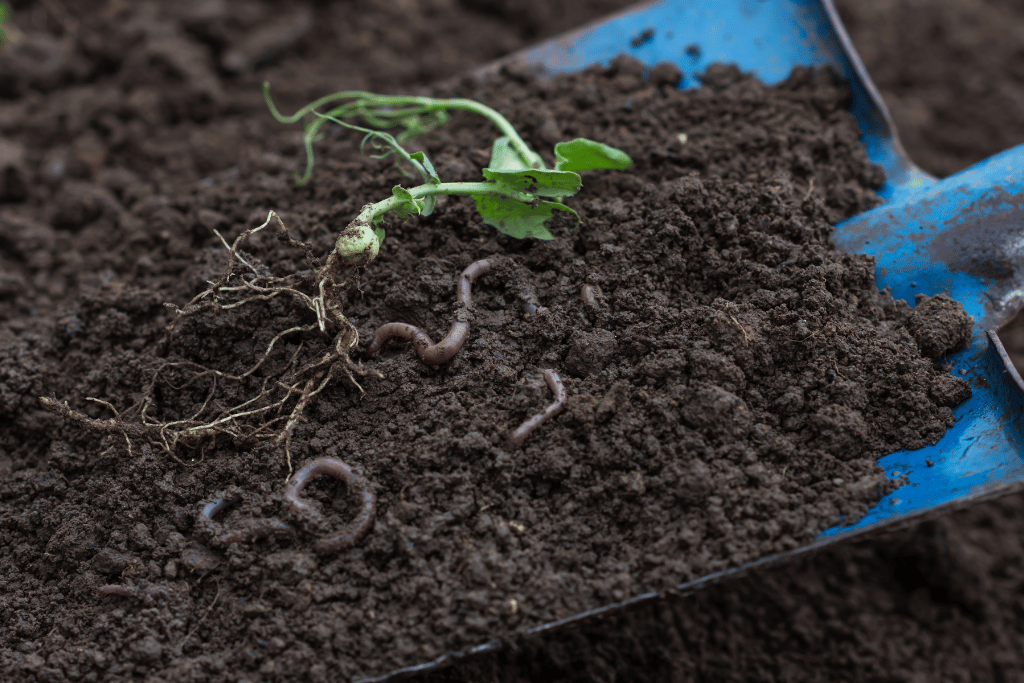
Earthworms are one of the most frequent visitors to any garden. They are not harmful to plants but, on the contrary, provide several benefits.
Red wigglers belong to the phylum Annelida, class Oligochaeta, and order Haplotaxida. They originated in Europe but are now found all over the world. They have long, slender, and cylindrical bodies that vary in size. Their skin is thin and moist, and their body color ranges from pale pink to reddish-brown.
These tiny cohabitants help to improve soil quality by accelerating the decomposition of organic matter and aerating the mix. Their burrows create channels in the soil, which aids water penetration and root growth. They also contribute to boosting soil fertility by excreting nutrient-rich castings, which are an excellent source of nitrogen, phosphorus, and potassium.
Earthworms belong to the most common types of worms in potted plants around the house. They are not harmful to the greenery but can occasionally have a negative impact on the roots. This is more likely to occur in soils that are overly compacted or poorly drained, as wigglers will move to the surface to escape these conditions. In such cases, they may nibble on the root of the plant, resulting in growth blockage and leaf discoloration.
If you suspect that your plants are infested, the best course of action is to elevate soil conditions. You can do this by adding compost or well-rotted manure to the potting mix. This ensures a more appropriate soil structure and drainage, encouraging earthworms to remain in the deeper layers of the soil.
4. Nematodes

Nematodes are small, worm-like creatures that can seriously impair fruits, vegetables, trees, flowers, and shrubs. They are often invisible to the naked eye but cause significant harm to your greens if left unchecked.
These types of worms in potted plants can be introduced to your garden through a variety of means. They usually hitch a ride on contaminated soil, plant material, or even on the shoes of a gardener who has been walking in an infected area.
The physical appearance of nematodes varies depending on the species, but they are typically thin and thread-like, measuring only a few millimeters in length. Some are clear or white, while others are yellow or brown. Most often, they attack roots, stems, and leaves.
If you think that your plants are ill, look for warnings like hindered growth, yellowing or wilting leaves, and deformed roots, which might even have bumps or knots on them.
When addressing the issue, it’s essential to first confirm the presence of these parasites by submitting a sample to a local agricultural extension office. There are a number of different treatment options available depending on the severity of the matter, including crop rotation or soil solarization.
5. Cutworms and Millipedes
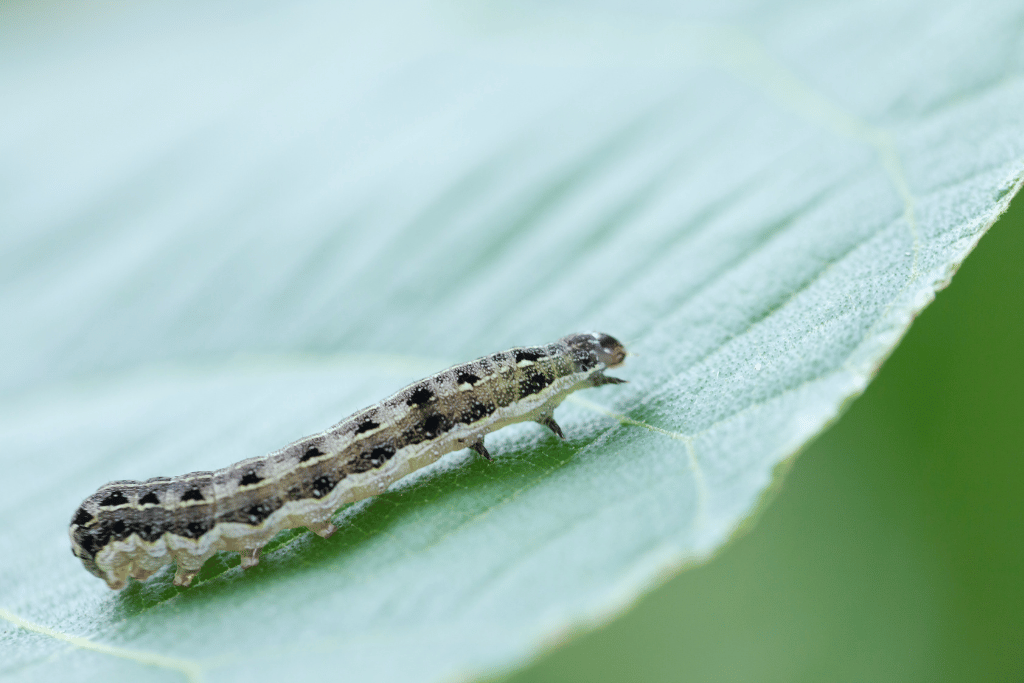
Cutworms are the larvae of diverse moth species. These little critters are named for their habit of cutting down young seedlings at the base, leading to the wilting and death of the plant. Cutworms are brown or gray and can grow up to an inch long. They are most active at night and tend to hide in the soil during the day, making them difficult to spot.
Millipedes are arthropods, therefore not insects, and rather belong to a separate class of animals. They come in a variety of colors and range in size from just a few millimeters to several inches long. These parasites are known for their defensive tactic of curling up into a tight ball when threatened, which is an impressive sight to behold.
Unfortunately, cutworms damage the base of young seedlings, while millipedes feed on roots, stems, and leaves. So, it’s better to get rid of these types of worms in potted plants.
For the former animal, consider placing collars made of paper or cardboard around the base of seedlings to prevent the pests from reaching them. You can also try handpicking the worms and disposing of them. As for the latter critter, you should attempt to reduce their numbers by removing any dead plant material from the garden and ensuring that the soil is well-draining. As an alternative solution, purchase a pest-repellent specifically designed to eliminate millipedes.
6. Beet armyworms
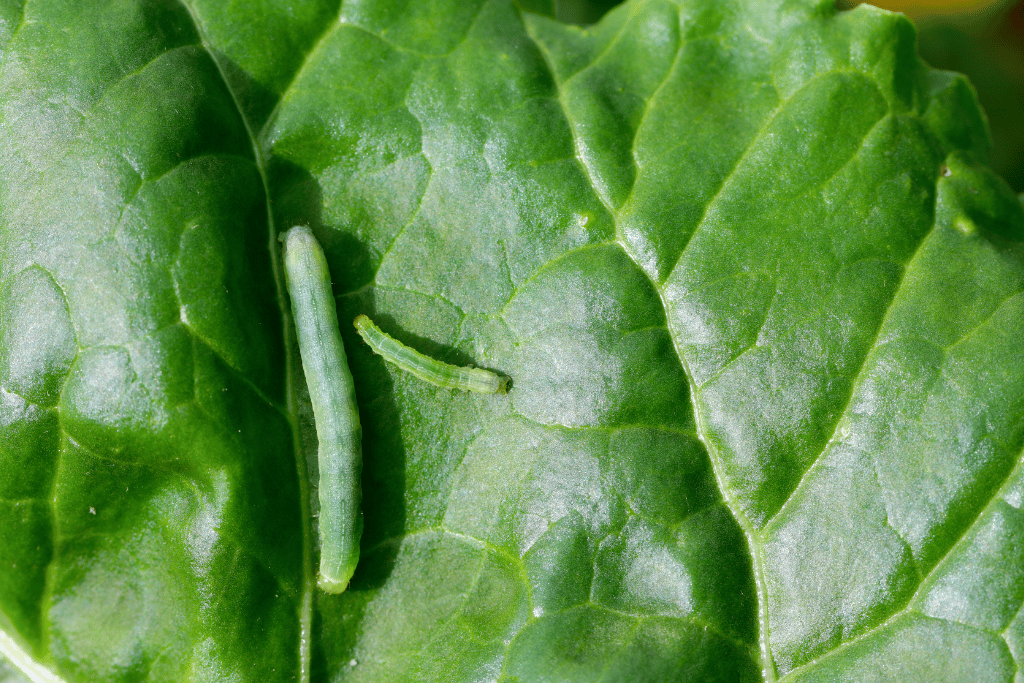
Beet armyworms may sound like a quirky name for a newfangled vegetable, but trust us, they’re no laughing matter in the garden. This pesky wrongdoer, also known as Spodoptera exigua, has an olive-green or brown body and stripes along its sides, and it poses a serious threat to your greenery. Members of the nightshade family, such as tomatoes, peppers, and eggplants are its favorite meal, but it considers beans and corn a great snack too.
Armyworms feast on leaves, buds, and even flowers. Look for any small holes in leaves, missing foliage, and general wilting. If left unnoticed, these pests can decimate a crop in no time.
So, what can you do if you spot such unwelcome visitors in your garden? The first step is to get them out of there! Removing them manually is an effective method if the infestation is not too severe. Insecticides can also work as an alternative, with organic options like Bacillus thuringiensis (Bt) and spinosad, which are safe for humans and pets but deadly to beet creatures. Prevention is also key, as healthy plants are less attractive to pests.
Final Words
Remember that discovering different types of worms in potted plants isn’t always a bad thing! Some of them are actually beneficial for your greens, while others are a detriment to them. Early identification is key to protecting plants and maintaining a healthy ecosystem. With some knowledge and attention, you can sustain thriving greenery and enjoy the beauty of your garden for a long time.
Frequently Asked Questions (FAQ)
Are all types of worms in potted plants beneficial?
No. In fact, a large population of them can be harmful to different parts of your lovely greens. However, in moderate numbers, pot worms contribute to the elevation of the soil quality by breaking down organic matter and releasing nutrients back into the soil. They also help to heighten water infiltration and air exchange in the soil.
How can I prevent parasites from ruining my plants?
First of all, it’s crucial not to overwater your plants. Larvae prefer moist soil, so allowing the mix to dry out more between waterings may be effective in reducing their amount. Additionally, you can add a layer of sand or perlite to the top of the soil, which blocks worms from smooth movement on the surface.
Can I use organic methods to control parasites in my potted plants?
Yes, organic solutions prove to be effective in keeping harmful critters under control. For example, use predators like birds to your advantage, or leverage plant extracts and essential oils like garlic or neem oil. Furthermore, companion planting is also an excellent way to repel unwanted intruders.
What are the signs of a nematode infestation in my potted plants or garden?
This nasty illness results in the plants losing their leaves, having deformed roots, and deteriorating. You may also notice that the affected greens are more susceptible to other pests and diseases.
Can different types of worms in potted plants attract other pests?
Yes, grub worms for instance tend to grab the attention of other pests and vermin like moles, skunks, and birds, which brings about further damage to your garden. So, it’s essential to address the issue as early as possible and take action to prevent further troubles.
How can I enhance soil conditions to discourage adverse vermin?
Improvement of the potting mix is essential for eliminating wiggly wrongdoers. One way to achieve more advantageous soil conditions is to work compost or well-rotted manure to the mix. Moreover, avoiding giving your plants too much to drink is a great method to boost water infiltration and aeration.
Can I reuse soil that has nematodes in it?
It’s best to avoid reusing the contaminated potting mix and solarize it by exposing it to high temperatures to kill the parasites.


